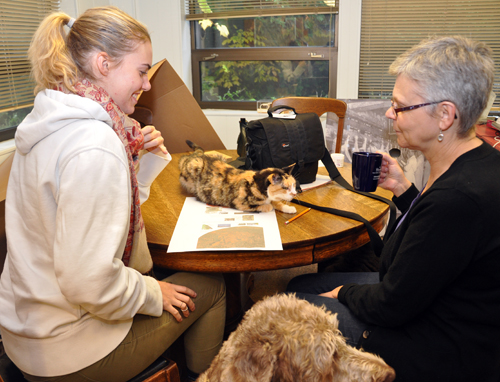
Tucked away in the woods of Eden Mills, Ont., is a former warehouse turned art and exhibit design studio where the University of Guelph’s 50th-anniversary exhibit for the Guelph Civic Museum is taking shape. It’s an odd location – even for an art studio – at the end of a dirt road surrounded by forest. There’s no parking lot, but there’s enough room to squeeze a few cars between the trees. A spring-fed pond and small vegetable garden are located nearby. Several cats and dogs roam freely around the studio, and no one’s ever too busy to give them a friendly pat or scratch behind their ears.
The studio is home to Vilnis Cultural Design Works, a family business owned and operated by Art and Sandy Lucs. “It’s pretty rustic,” says their son Jacob, who works for them.
On an October afternoon, several U of G art students were busy assembling, sanding and priming a large wooden hexagonal box designed to resemble a honeycomb cell. Other students were putting together mock honeycombs containing fact sheets about bees and pollination.
The hive is part of an interactive exhibit celebrating U of G’s 50th anniversary and the conclusion of the BetterPlanet Project (BPP) fundraising campaign in 2014. Installation will begin in December, and the official opening is scheduled for Jan. 4. The 1,000-square-foot exhibit will be located in the community gallery of the Guelph Civic Museum and address the four pillars of the BPP: food, environment, health and community.
The studio is located on a former gravel pit whose gravel was used to build a railway that once grazed the property. Cedars have since taken over the now-dormant railway; all that remains is a linear gap between the trees. When the Lucs purchased the former warehouse 11 years ago, they intended to use it as a studio and offices but eventually converted the second floor into their residence. “I actually don’t know anyone else who’s done it: renovate a steel warehouse into living quarters,” says Art.
One of the Lucs’ biggest claims to fame is the hallway that leads to the President’s Office on the fourth floor of the University Centre. One of the most recognizable works of art on campus, the hallway was painted with U of G-coloured stripes interspersed with a timeline of photos that highlight milestones from the University’s past. Other U of G projects that bear the Lucs’ name include the Dr. Frank Schofield Memorial Seminar Room in the new Pathobiology/Animal Health Laboratory building and a gallery commemorating writer Lucy Maud Montgomery.
When the Lucs were commissioned to paint the hallway, Sandy researched the University’s history and developed an interpretive plan; Art designed the colour scheme and worked with Jacob on the graphic panels. “The mandate was to liven up the hallway,” says Sandy, “and to have visitors more aware of the University’s history.”
The Lucs’ passion for art and history laid the foundation for their business. Art, a sculptor, painter and graphic designer, studied at the University of Toronto; Sandy studied archeology at Simon Fraser University and volunteered at a local museum. “I found museums really fascinating,” she says. She did a master’s degree in museum studies at the University of Toronto and worked at the Halton Regional Museum for 10 years. Jacob was recently certified as a registered graphic designer. The Lucs now specialize in designing museum exhibits: “Our bread and butter is exhibits we do together — it’s a really competitive business,” says Sandy.
Several U of G students taking Museum Project 1, 2 and 3 are working on the exhibit as part of a class project led by Sue Bennett, director of university and community relations, who teaches the courses. “In planning for the University’s 50th anniversary, I wanted to develop commemorative projects and campus-wide events that engage faculty, staff, students and the broader community,” says Bennett. “These three courses have been designed to provide students with real-world experience and the opportunity to develop transferable skills.”
In their first semester, the students researched and prepared an interpretive plan; in their second semester, they designed a model of the exhibit to present to the 50th-anniversary committee.
Now in their third semester, the students are assembling the exhibit, which showcases the University’s many innovations and contributions to the planet over the past 50 years. One wall will be dedicated to the seeds of plants developed by U of G researchers. Another exhibit, called “Let’s Go Shopping,” will display foods developed by U of G, such as the Yukon Gold potato and Omega-3 enhanced eggs.
The Lucs recently held a focus group at the museum, where they tested the exhibit’s user-friendliness on children and their families. Sandy says it’s important to get feedback from museum visitors, although it’s often not a priority for museums because of time and budgetary constraints. They will also test the exhibit’s accessibility by moving through the mock-up using a wheelchair.
Not only do the students get marked for their work, but they also use their experience on the project to build their portfolios. “The majority of us are art history students,” says third-year art history student Ailish Farrelly. “This is a really helpful learning process for making a proper exhibit.”
The hands-on experience they gain at the studio gives them a competitive edge in their job search, she adds. “It’s very difficult to find jobs, because a lot of people have the education but not the experience. This course gives us the education and the experience.” The students also develop a variety of skills, from sourcing artifacts such as the red lamps that once hung in the UC cafeteria to painting a cow-shaped piece of plywood to doing graphic design.
“It’s a steep learning curve, but they seem to handle it pretty well,” says Sandy.
